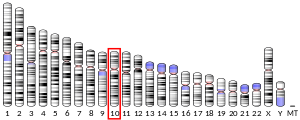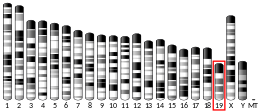B-cell linker
Mammalian protein found in Homo sapiens From Wikipedia, the free encyclopedia
B-cell linker (BLNK) protein is expressed in B cells and macrophages and plays a large role in B cell receptor signaling.[5] Like all adaptor proteins, BLNK has no known intrinsic enzymatic activity.[6] Its function is to temporally and spatially coordinate and regulate downstream signaling effectors in B cell receptor (BCR) signaling, which is important in B cell development.[7] Binding of these downstream effectors is dependent on BLNK phosphorylation.[8][9] BLNK is encoded by the BLNK gene[8][10] and is also known as SLP-65,[11] BASH,[12] and BCA.[13]
| BLNK | |||||||||||||||||||||||||||||||||||||||||||||||||||
|---|---|---|---|---|---|---|---|---|---|---|---|---|---|---|---|---|---|---|---|---|---|---|---|---|---|---|---|---|---|---|---|---|---|---|---|---|---|---|---|---|---|---|---|---|---|---|---|---|---|---|---|
| |||||||||||||||||||||||||||||||||||||||||||||||||||
| Identifiers | |||||||||||||||||||||||||||||||||||||||||||||||||||
| Aliases | BLNK, AGM4, BASH, BLNK-S, LY57, SLP-65, SLP65, bca, B-cell linker, B cell linker | ||||||||||||||||||||||||||||||||||||||||||||||||||
| External IDs | OMIM: 604515; MGI: 96878; HomoloGene: 32038; GeneCards: BLNK; OMA:BLNK - orthologs | ||||||||||||||||||||||||||||||||||||||||||||||||||
| |||||||||||||||||||||||||||||||||||||||||||||||||||
| |||||||||||||||||||||||||||||||||||||||||||||||||||
| |||||||||||||||||||||||||||||||||||||||||||||||||||
| |||||||||||||||||||||||||||||||||||||||||||||||||||
| |||||||||||||||||||||||||||||||||||||||||||||||||||
| Wikidata | |||||||||||||||||||||||||||||||||||||||||||||||||||
| |||||||||||||||||||||||||||||||||||||||||||||||||||
Structure and localization
BLNK consists of a N-terminal leucine zipper motif followed by an acidic region, a proline-rich region, and a C-terminal SH2 domain.[14][5] The leucine zipper motif allows BLNK to localize to the plasma membrane, presumably by coiled-coil interactions with a membrane protein.[5] This leucine zipper motif distinguishes BLNK from lymphoctye cytosolic protein 2, also known as LCP-2 or SLP-76, which plays a similar role in T cell receptor signaling.[15] Although LCP-2 has an N-terminal heptad-like organization of leucine and isoleucine residues like BLNK, it has not been experimentally shown to have the leucine zipper motif.[16] Recruitment of BLNK to the plasma membrane is also achieved by binding of the SH2 domain of BLNK to a non-ITAM phospho-tyrosine on the cytoplasmic domain of CD79A, which is a part of Igα and the B cell receptor complex.[17][18][19]
Function
Summarize
Perspective

BLNK's function and importance in B cell development were first illustrated in BLNK deficient DT40 cells, a chicken B cell line.[7] DT40 cells had interrupted B cell development: there was no calcium mobilization response in the B cell, impaired activation of the mitogen-activated protein (MAP) kinases p38, JNK, and somewhat inhibited ERK activation upon (BCR) activation as compared to wild type DT40 cells.[7] In knockout mice, BLNK deficiency results in a partial block in B cell development,[20][21] and in humans BLNK deficiency results in a much more profound block in B cell development.[22][5]
Linker or adaptor proteins provide mechanisms by which receptors can amplify and regulate downstream effector proteins.[6] BLNK is essential for normal B-cell development as part of the B cell receptor signaling pathway. [supplied by OMIM][10][23][24]
Evidence also suggests that BLNK may have tumor suppressive activity through its interaction with Bruton's tyrosine kinase (Btk) [25][26] and regulation of the pre-B cell checkpoint.[14][27]
Phosphorylation and interactions
The acidic region of BLNK contains several inducibly phosphorylated tyrosine residues, at least five of which are found in humans.[28] Evidence suggests that BLNK is phosphorylated by the tyrosine-protein kinase Syk after B cell receptor activation.[8][9][24][29] Phosphorylation of these residues provides docking sites necessary for downstream protein-protein interactions between BLNK and the SH2 domain-containing proteins Grb2,[8][11][17][30] PLCG2, Btk, the Vav protein family, and Nck.[31][9][8] BLNK has also been shown to interact with SH3KBP1[32] and MAP4K1.[33] A more recent mass spectrometry study of BLNK in DT40 cells found that at least 41 unique serine, threonine, and tyrosine residues are phosphorylated on BLNK.[34]
References
Further reading
External links
Wikiwand - on
Seamless Wikipedia browsing. On steroids.





